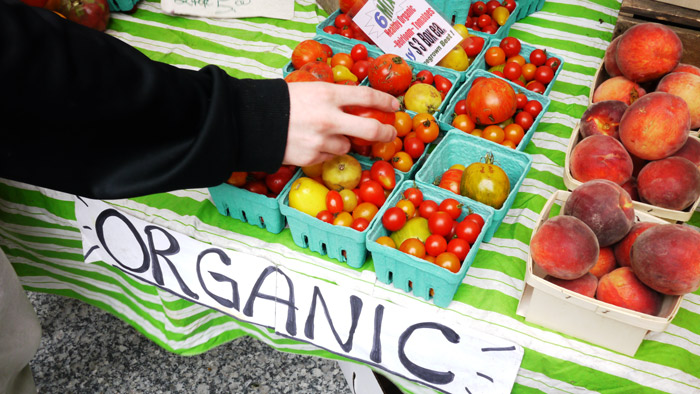How About Eating Organic
Summary
Intro: the interest in eating organic
Step 1: Find out where to buy organic products.
Step 2: Identify organic products
Step 3: Give priority to organic fats and oils.
Step 4: Prefer organic dairy products.
Step 5: Make your choice of organic fruits and vegetables.
Step 6: Buy organic eggs.
Eating organic food helps avoid over-damaging the body, subject to numerous daily aggressions: pollution, stress, etc… But this represents a cost. If you need to select among the products to be preferred in the organic section, here are the essentials and useful advice on finding and choosing them.
The interest in eating organic
Eating organic has health and environmental benefits.
Organic products contain fewer traces of chemicals, heavy metals, and antibiotics. They are oxidants for the human body that attack and damage it. Traces of antibiotics in some non-organic products, such as animal products, promote antibiotic resistance, which has become a significant public health problem.
Organic products are richer in quality nutrients. As an example, cows from organic farms eat grass. Their fats are sources of omega 3, unlike those of non-organic cows. Several studies have also shown that organic plants are better sources of polyphenols and antioxidants than their non-organic counterparts.
Organic crops and livestock are environmentally friendly. Crops respect the soil by avoiding the use of chemicals; livestock farms protect animals from stress, prefer healthy feed, and avoid antibiotics’ systematic use.
Good to know: every day, there are reportedly 81 harmful chemicals in the children’s meals. Several studies comparing urinalysis of exclusively organic and non-organic eating children have shown that organic food can quickly eliminate these substances from the body.
1. Find out where to buy organic food
To find organic products, you can use several distribution channels, from the most local to the most industrial.
Directly from the organic farmer: some even open small stores on their farm.
Markets with stands of organic producers: the sale is direct from the producer to the consumer, but note that there are not always organic merchants on all markets. They are rarer in big cities than farmer markets, and the price of the products can then be multiplied by two.
Organic stores offer unprocessed and processed organic products. You can find everything in one place. There are no rules, so be patient and regularly compare prices from one store to another.
The organic sections of supermarkets, including hard discount stores: the organic section is usually less crowded than all the other divisions, but the offers are increasingly varied and exciting in price.
Warning: organic discount products are generally imported products: greenhouse gas emissions due to transportation are contrary to the concept of organic, which prefers to be local and protect the environment. Local producers are also impacted since they sell less, which jeopardizes their exploitation. Similarly, products’ seasonality is not always respected in discount stores, and international organic labels do not always meet Canadian organic labels’ requirements. Ecocert, the controlling body of organic products, has also discovered many frauds.
2. Identify organic products

Under the Safe Food for Canadians Regulations (SFCR), any food, seed, or animal feed with organic labels affixed on the packaging attest to the organic quality of the products which is regulated by the Canadian Food Inspection Agency (CFIA).
For example, the Canada Organic Logo symbolizes labels grouped under the Organic Federation of Canada.
3. Give priority to organic fats and oils
Because they trap the most pollutants, the first good thing to do is to switch to organic fats. Their price remains affordable.
Organic vegetable oils (coconut, sunflower, peanut, olive, rapeseed, flax, walnut, hazelnut, canola) and margarine (vegetable butter): the transformation processes of organic plants that will give these products are mechanical and not chemical. Indeed, the extraction can take place using a solvent harmful to health, and industrial refining destroys the oils’ properties.
Organic butter, from animals fed in pastures, is a source of omega 3. It is an organic product that remains very accessible because it will only cost you a few cents more per tablet than non-organic butter.
Tip: if you want to eat fatty meats such as veal tendons, duck, veal or pork chops taken from the spine, belly or fatty fish such as salmon, sardines, anchovies, mackerel or tuna, also prefer organic products.
4. Prefer organic dairy products
Milk, dairy products and non-organic cheeses also contain many traces of pesticides from the feed of milk-producing animals, antibiotics from their treatment in intensive farming, in addition to the growth factors naturally present in milk.
Organic dairy products come from animals raised on pasture or with fodder.
The animals selected for organic milk production are robust. If they fall ill, alternative medicine is used primarily to treat them.
Organic milk is more controlled than standard milk because the regulations are more demanding. Organic regulations prohibit the use of many authorized additives for the manufacture of non-organic dairy products.
Good to know: there is not much difference in price between organic and non-organic yogurts.
5. Choosing among organic fruits and vegetables
Fruits such as strawberries and raspberries, citrus fruits, and vegetables like cucumbers, zucchini, peppers, salad, pulses and potatoes are the most contaminated. So, if you have to choose organic food, ideally, this kind of food should land in your basket.
6. Buy organic eggs
The organic eggs come from hens raised in the open air. They carry the code 0. They are less likely to have a bacterium called salmonella than their battery-farmed counterparts.
Organic eggs from hens fed with flaxseed have a yolk that is a source of omega 3.
Good to know: the difference between organic and free-range eggs lies in the number of hens per farm. In an organic farm, the flock size is a maximum of 3,000 hens (there is no maximum farm size for non-organic hens), and there are only 6 hens/square meters compared to 9 for non-organic hens raised outdoors. Their outdoor runs are conducted according to the rules of organic farming. A certifying body carries out controls, and their feed is 95% organic and without synthetic colouring.
Hope the above helps you out. Next time your doctor or dietician or a friend of yours talks about eating organic, you’ll know what it is all about.



